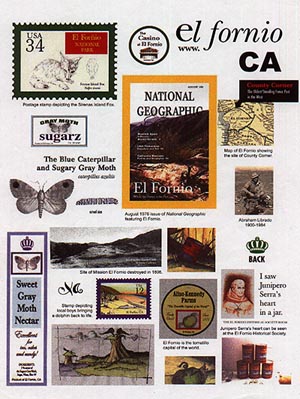
Listen
to voice over artist Tim George

read
the part of Hank Peabody
Visit
Tim George's website to learn more
about his work
www.timgeorgevo.com
From My Desk
at the Historical Society
from The Reeducation
of a Turd Peddler
by John Henry Peabody
FROM MY DESK at the historical
society, I could see the “Oldest Standing Fence Post in the West,”
a tall piece of unmilled California sycamore, standing around six feet,
set in a reliquary in the corner. On the door of the narrow reliquary
was a bolted brass plaque engraved with the post’s California landmark
number and other descriptors.
[SEE]
It came from a place called County Corner, a little bishop’s
hat of a tip on the map where El Fornio pointed into San Luis Obispo
county to the north. At one time it had been a cairn, or codified pile
of rocks, denoting tribal areas outlined before the arrival of the Spanish.
In the 1920s, the local gentry replaced the original post with a new
piece of wood, bringing the old stick to the historical society where
I gandered at it everyday eating lunch at my desk.
[SEE]
An autographed copy of “The Trails of El Fornio”
movie poster, the Robert Mitchum and Ava Gardner vehicle based on the
Mark Twain story, hung on one wall, with other bits of memorabilia from
the film laid, like coprolites, beneath the display case. [SEE]
Old maps of the county and coast, going back as far as Viscaino’s
1603 voyage, hung from some walls. And scattered corkboard pitched in
edges of the building held announcements as old as two days to a decade,
the corners crucified by plasticpush pins. [SEE]
We had total kit and caboodle. There were paintings of oak
trees, falling barns and angry seas. Drawings of gall wasp nests hung
next to real gall wasp nests, and geologic oddities like carbuncles
of iron oxide and fossilized shark teeth littered the shelves beneath.
[SEE]
We had baby dolphins and lobsters and tarantulas floating
in jars. Display cases with black leather trim held dried and pinned
moths, their blue caterpillars mummified in salts. Oxidized blue moth
sugar candy clung to Victorian bottles filled with glaucal nectar. [SEE]
On the wall outside of the men’s room was an installation
dedicated completely to El Fornio Brand Dolphin Meat™ and its mascot
Little Nunzio. Before tourists came to swim with the dolphins, people
actually ate dolphin—not Mahi mahi, El Dorado dolphin, but Flipper
“I’ve Got A TV Show” dolphin. [SEE]
The Japanese came in the Twenties and Thirties, before the
war, as they considered the meat a delicacy (still do [SEE]).
Nishino Kozo, the commander of the I-17 Japanese submarine that bombed
Ellwood Beach, north of Santa Barbara, on February 23, 1942 (and landed
with his crew the following night on the beach at El Fornio), he ate
dolphin on his visit to California in the 1930s.
[SEE]
The five-inch figurine that was Little Nunzio was a bit
of daff marketing. Dressed in his white chef’s coat and hat, looking
New York Italian, Little Nunzio was known to thousands of households
as the face of El Fornio Brand Dolphin meat. With his Bronx leanings,
the little plastic man said that California had to be something else,
something Back East, or even farther, before it could be thought of
as its own. [SEE]
And, yes—we had Junipero Serra’s heart in jar.
Had had Serra’s heart. Before we didn’t have it, anymore—we
had it. [SEE]

Who Stole Junipero Serra's Heart in a Jar?
|

